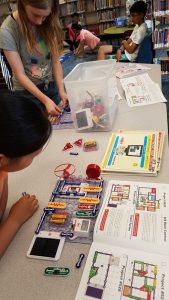 Thanks to a grant from the Burnaby School District, Seaforth was recently able to purchase several kits to support the new Applied Design, Skills, and Technology (ADST) curriculum, which has been extended to all levels from Kindergarten on up. School libraries intend to support all kinds of literacy development: digital literacy just as much as print literacy, information literacy, and critical literacy, and so we have been running sessions in the library to help students learn to use the kits.
Thanks to a grant from the Burnaby School District, Seaforth was recently able to purchase several kits to support the new Applied Design, Skills, and Technology (ADST) curriculum, which has been extended to all levels from Kindergarten on up. School libraries intend to support all kinds of literacy development: digital literacy just as much as print literacy, information literacy, and critical literacy, and so we have been running sessions in the library to help students learn to use the kits.
Grade 6 and 7 students from Mr. Hodges’, Mr. Aujla’s, and Mr. Brockerville’s classes volunteered their time and expertise to act as tutors for the younger students (and as furniture movers to clear the floor for the activities), and for their reward, only a handful of gold chocolate coins (a legacy from Ms Higgins).
This was a learning experience for the older students as well as the younger ones: learning the skills needed to lead a group of younger students through the mysteries of programming is not just a walk in the park! The photos below tell only part of the story. I chose these photos because they are representative of the work/play we did in the library, but virtually every photograph I took would have demonstrated this, and I took dozens! I just didn’t have room to display all of them. Thank you to every one of the peer tutors who donated their time, energy, and expertise with such kindness and generosity.
And in case you’re wondering if students who are having this much fun could also be learning, the answer is “Yes,” for the reasons outlined in the BC Ministry of Education curriculum guidelines for ADST:
In the early years, students delve into the ADST curriculum through exploratory and purposeful play. As they get older and both broaden and deepen their interests and passions, they have opportunities to develop foundational skills that have a practical, creative, and real-life focus.
(from BC Ministry of Education ADST Introduction).
Some of the photos below have ‘hotspots,’ which if you click on them will give you more detailed information. If you click on the ‘Full Screen’ icon in the right corner of each image, use the ‘Escape’ button to exit full screen mode and return to the post. And when you’re done reading the post, click the ‘Back’ button on your browser to return to the blog Mainpage.
Spheros: The nice thing about Spheros is how versatile they are–at the simplest level you can use them as Remote Controlled Devices; or you can do very basic ‘programming’ by drawing a path with your finger; or you can program them to do all kinds of tricks using blocks of code, very much like the Scratch coding program: the difference is that with a Sphero, you see the results in the real world, instead of just on a screen. You can even program them to make sounds and talk (although this can be a somewhat annoying feature for those of us who are within earshot of the smoke detector sound, for example).
We purchased ten of these kits with grant money from the Burnaby School District, and another five with a grant from the VanCity Youth Credit Union which was presented to Seaforth for our participation in the Youth Credit Union program by Ms Grace Yule from VanCity at the May COLA assembly. (To learn more about the VanCity Youth Credit Union program, follow this link and scroll down to “1996 Bullet Point 3”)
Dash and Dot is similar to Sphero in that it is programmable using an app on an iPad, but it is simpler to use. It’s actually two robots–Dash is the larger one made of multiple spheres, and Dot is the stand-alone single sphere. You can get a variety of accessories to attach and program–this Xylophone created a welcome melodic ambiance in the library. The ballista attachment was maybe a shade less welcome, as the plastic balls were lobbed into the room. But still . . . you can see the students enjoy it, peer tutors and learners alike.
Snap Circuits: Digital literacy is about understanding how electronic circuits work (the hardware) as much as it is knowing how to program devices (the software). This kit is designed to introduce students to this kind of hands-on knowledge about the hardware. Because it is more complex, it appeals more to intermediate than primary students. However, even though it is a more sophisticated activity, the included instruction manuals allow it to be a more self-directed one.
Keva Planks: You may have seen them; maybe you even have a set. It might seem surprising in this era of bells and whistles and amazing electronic toys, but these simple wooden blocks have turned out to be one of the most popular kits in our collection: tied only with the Spheros for first place. And not just for very young children either!
The inspiration for the ‘Thinking Outside the Box–With a Box’ project came from this book, The Most Magnificent Thing by Ashley Spires (because every adventure could use a good story). The suggestion for Seaforth to undertake this project came from Ms Scott. Principal Hiltz acted as the principal cheerleader. And the entire school participated in the project before the Winter Break. You can see just some of the magnificent results in the photos above. The success of this project inspired Mr. Hodges to purchase the makedo kit so future engineers and artists can continue to practice their creative skills. (And by the way, fans of the book can soon watch the animated film).
The world is out there. Here are some of the other kits we have purchased:
Floor puzzles (Safari Floor Puzzle (shown); Underwater Floor Puzzle; World Map Floor Puzzle ): It’s not just digital tools that require problem solving and pattern-finding skills. Many of us get great pleasure from working on puzzles like these, which result in satisfyingly large finished pictures.
Lego Boost: This is a toy that teaches children to program robots made of Lego pieces. Although it is very intuitive to use, it requires more time to build than we had during the library sessions.
MakeyMakey: This kit allows you to connect everyday objects to computer programs. You can use play-dough (or PlayDoh), or bananas, or whatever else you have at hand, to make controllers for circuit boards. A banana-key piano, for instance. Helps learners understand WHY someone would want to learn programming, not just how to do it.
MIND Designer Robot: This is a more sophisticated, programmable robot which you can operate in three different modes: Free Play, Educational, or App. You can use it to play math games, to solve puzzles, or to draw pre-programmed geometrical shapes. You can command it via code, drawing, or voice commands.
What is ADST?
The Applied Design, Skills, and Technologies (ADST) curriculum is “an experiential, hands-on program of learning through design and creation that includes skills and concepts from traditional and First Peoples practice; from the existing disciplines of Business Education, Home Economics and Culinary Arts, Information and Communications Technology, and Technology Education; and from new and emerging fields. It fosters the development of the skills and knowledge that will support students in developing practical, creative, and innovative responses to everyday needs and challenges.” (from BC Ministry of Education ADST Introduction)
The understanding of how to achieve progressively deeper student engagement from play-based learning is reflected in the uTEC Maker Model, which was developed by Teacher Librarians as support for creating MakerSpaces in school libraries. It shows the stages of learning that result from giving students free, relatively unstructured play time, leading (potentially) to progressively more intensive levels of involvement:
Click here to go back to the blog Mainpage.